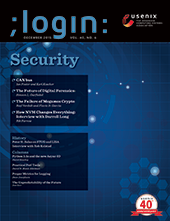
Interview with Darrell Long
;login: Enters a New Phase of Its Evolution
For over 20 years, ;login: has been a print magazine with a digital version; in the two decades previous, it was USENIX’s newsletter, UNIX News. Since its inception 45 years ago, it has served as a medium through which the USENIX community learns about useful tools, research, and events from one another. Beginning in 2021, ;login: will no longer be the formally published print magazine as we’ve known it most recently, but rather reimagined as a digital publication with increased opportunities for interactivity among authors and readers.
Since USENIX became an open access publisher of papers in 2008, ;login: has remained our only content behind a membership paywall. In keeping with our commitment to open access, all ;login: content will be open to everyone when we make this change. However, only USENIX members at the sustainer level or higher, as well as student members, will have exclusive access to the interactivity options. Rik Farrow, the current editor of the magazine, will continue to provide leadership for the overall content offered in ;login:, which will be released via our website on a regular basis throughout the year.
As we plan to launch this new format, we are forming an editorial committee of volunteers from throughout the USENIX community to curate content, meaning that this will be a formally peer-reviewed publication. This new model will increase opportunities for the community to contribute to ;login: and engage with its content. In addition to written articles, we are open to other ideas of what you might want to experience.

The Intel/Micron announcement of XPoint 3D in July 2015 really got my attention: finally, a vendor will start shipping a form of nonvolatile memory (NVM) that’s not NAND flash. XPoint 3D promises to be byte addressable, faster, more durable, and require lower power than any form of flash today. The downsides (there are always downsides) will be that XPoint 3D will be more expensive and have less storage capacity when it appears in early 2016.
Having byte-addressable NVM will have impacts on the way computers are designed and operating systems and software are written. If this technology proves to be everything that Intel and Micron are promising, it might change everything about the systems we are familiar with. At the very least, XPoint 3D would become a new tier in the storage hierarchy.
I asked around, trying to find someone I knew in our community who could address this topic from a file system and storage perspective. The timing was terrible, as all of the people I asked (who responded) were busy preparing FAST ’16 papers for submission, and with two deadlines at about the same time, you can guess which one is the more important.
Darrell Long, a professor at UCSC, took up my challenge, even though he too was busy on an overseas trip, as well as supervising papers to be submitted to FAST ’16. Long has experience in both storage systems and operating systems, and seemed like the right person to talk to about this development.
